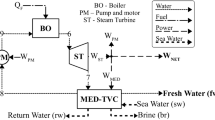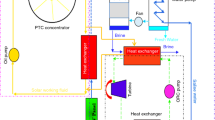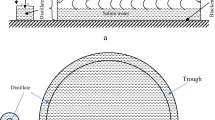Abstract
In this research, the optimum situation for the function of a combined cycle power plant (CCPP) which simultaneously generates water and electricity with parabolic solar collectors has been scrutinized. The CCPP includes two gas cycles and one steam cycle in which a multi-stage vapor desalination and a parabolic solar collector have been added. In this stage, first, the thermodynamic cycle of the CCPP has been modeled, and values of exergy and energy in each flow line and the power plant component were determined. Finally, exergy destruction in each section is calculated. For a better assessment of the system, an economic analysis of power plant is performed by using SPECO method. The results revealed that as the number of desalination effect increased from 4 to 8 and the exergy efficiency decreased from 52.7 to 52.4%. Moreover, there was an increase in the cost of electricity generation by 12%, and the interest rate of freshwater production increased from 6 to 12 due to the increase in the number of effects. The power plant optimization results show that the exergy efficiency increases to 53.62%, which indicates a growth of 1.74%.







Similar content being viewed by others
Abbreviations
- c :
-
Cost per exergy unit ($ (MJ)−1)
- c f :
-
Cost of fuel per energy unit ($ (MJ)−1)
- \(\dot{C}\) :
-
Cost flow rate ($ s−1)
- c p :
-
Specific heat at constant pressure (kJ kg−1 K−1)
- CRF:
-
Capital recovery factor
- \(\dot{{\rm Ex}}\) :
-
Exergy flow rate (MW)
- \({\dot{{\rm Ex}}}_{\rm D}\) :
-
Exergy destruction rate (MW)
- ex:
-
Specific exergy (kJ kg−1)
- i :
-
Annual interest rate (%)
- h :
-
Specific enthalpy (kJ kg−1)
- h 0 :
-
Specific enthalpy at environmental state (kJ kg−1)
- LHV:
-
Lower heating value (kJ kg−1)
- \(\dot{m}\) :
-
Mass flow rate (kg s−1)
- n :
-
Number of years
- N :
-
Number of hours of plant operation per year
- PP:
-
Pinch point
- \(\dot{Q}\) :
-
Heat transfer rate (kW)
- \(r_{\text{AC}}\) :
-
Compressor pressure ratio
- \(s\) :
-
Specific entropy (kJ kg−1 K−1)
- \(s_{0}\) :
-
Specific entropy at environmental state (kJ kg−1 K−1)
- \(\dot{W}_{\text{net}}\) :
-
Net power output (MW)
- \(Z\) :
-
Capital cost of a component ($)
- \(\dot{Z}\) :
-
Capital cost rate ($ s−1)
- \(\eta\) :
-
Isentropic efficiency
- \(\xi\) :
-
Coefficient of fuel chemical exergy
- \(\varPhi\) :
-
Maintenance factor
- a:
-
Air
- AC:
-
Air compressor
- CC:
-
Combustion chamber
- CCPP:
-
Combined cycle power plant
- ch:
-
Chemical
- Cond:
-
Condenser
- COE:
-
Cost of electricity
- GT:
-
Gas turbine
- HP:
-
High pressure
- HRSG:
-
Heat recovery steam generator
- IAM:
-
Incidence angle modifier
- LP:
-
Low pressure
- MED:
-
Multi-effect distillation
- MSF:
-
Multi-stage flash
- ph:
-
Physical
- ST:
-
Steam turbine
- SWRO:
-
Sea water reverse osmosis
- TVC:
-
Thermal vapor compression
- w:
-
Water
References
Hornburg CD, Cruver JE. Dual purpose power/water plants utilizing both distillation and reverse osmosis. Desalination. 1977;20:27–42.
El-Nashar AM, El-Baghdady A. Analysis of water desalination and power generation expansion plans for the Emirate of Abu Dhabi—a preliminary study. Desalination. 1984;49:271–92.
Kronenberg G, Lokiec F. Low-temperature distillation processes in single- and dual-purpose plants. Desalination. 2001;136:189–97.
Javadi MA, Hoseinzadeh S, Khalaji M, Ghasemiasl R. Optimization and analysis of exergy, economic, and environmental of a combined cycle power plant. Sādhanā. 2019;44:121.
Rensonnet T, Uche J, Serra L. Simulation and thermoeconomic analysis of different configurations of gas turbine (GT)-based dual-purpose power and desalination plants (DPPDP) and hybrid plants (HP). Energy. 2007;32:1012–23.
Mahbub F, Hawlader MNA, Mujumdar AS. Combined water and power plant (CWPP)—a novel desalination technology. Desalin Water Treat. 2009;5:172–7.
He WF, Zhu WP, Xia JR, Han D. A mechanical vapor compression desalination system coupled with a transcritical carbon dioxide Rankine cycle. Desalination. 2018;425:1–11.
Ramezanizadeh M, Alhuyi Nazari M, Ahmadi MH, Açıkkalp E. Application of nanofluids in thermosyphons: a review. J Mol Liq. 2018;272:395–402.
Habibollahzade A, Gholamian E, Ahmadi P, Behzadi A. Multi-criteria optimization of an integrated energy system with thermoelectric generator, parabolic trough solar collector and electrolysis for hydrogen production. Int J Hydrogen Energy. 2018;43:14140–57.
Sadi M, Arabkoohsar A. Exergoeconomic analysis of a combined solar-waste driven power plant. Renew Energy. 2019;141:883–93.
Wang J, Lu Z, Li M, Lior N, Li W. Energy, exergy, exergoeconomic and environmental (4E) analysis of a distributed generation solar-assisted CCHP (combined cooling, heating and power) gas turbine system. Energy. 2019;175:1246–58.
Ortega-Delgado B, Cornali M, Palenzuela P, Alarcón-Padilla DC. Operational analysis of the coupling between a multi-effect distillation unit with thermal vapor compression and a Rankine cycle power block using variable nozzle thermocompressors. Appl Energy. 2017;204:690–701.
Sharan P, Neises T, McTigue JD, Turchi C. Cogeneration using multi-effect distillation and a solar-powered supercritical carbon dioxide Brayton cycle. Desalination. 2019;459:20–33.
Yilmaz F. Thermodynamic performance evaluation of a novel solar energy based multigeneration system. Appl Therm Eng. 2018;143:429–37.
Ghorbani B, Mahyari KB, Mehrpooya M, Hamedi M-H. Introducing a hybrid renewable energy system for production of power and fresh water using parabolic trough solar collectors and LNG cold energy recovery. Renew Energy. 2020;148:1227–43.
Demir ME, Dincer I. Development of an integrated hybrid solar thermal power system with thermoelectric generator for desalination and power production. Desalination. 2017;404:59–71.
Ansari M, Beitollahi A, Ahmadi P, Rezaie B. A sustainable exergy model for energy–water nexus in the hot regions: integrated combined heat, power and water desalination systems. J Therm Anal Calorim. 2020. https://doi.org/10.1007/s10973-020-09977-1.
Al-Mutaz IS, Wazeer I. Development of a steady-state mathematical model for MEE-TVC desalination plants. Desalination. 2014;351:9–18.
Javadi MA, Hoseinzadeh S, Ghasemiasl R, Heyns PS, Chamkha AJ. Sensitivity analysis of combined cycle parameters on exergy, economic, and environmental of a power plant. J Therm Anal Calorim. 2020;139:519–25.
Javadi MA, Khalaji M, Ghasemiasl R. Exergoeconomic and environmental analysis of a combined power and water desalination plant with parabolic solar collector. Desalin Water Treat. 2020;193:212–23.
Hoseinzadeh S, Ghasemiasl R, Javadi MA, Heyns PS. Performance evaluation and economic assessment of a gas power plant with solar and desalination integrated systems. Desalin Water Treat. 2020;174:11–25.
Ozgener O, Hepbasli A. Exergoeconomic analysis of a solar assisted ground-source heat pump greenhouse heating system. Appl Therm Eng. 2005;25:1459–71.
Javadi MA, Ahmadi MH, Khalaji M. Exergetic, economic, and environmental analyses of combined cooling and power plants with parabolic solar collector. Environ Prog Sustain Energy. 2019;39:e13322.
Adibhatla S, Kaushik SC. Energy, exergy and economic (3E) analysis of integrated solar direct steam generation combined cycle power plant. Sustain Energy Technol Assess. 2017;20:88–97.
Bejan A, Tsatsaronis G, Moran MJ. Thermal design and optimization. Hoboken: Wiley; 1995.
Rosen MA, Dincer I. Thermoeconomic analysis of power plants: an application to a coal fired electrical generating station. Energy Convers Manag. 2003;44:2743–61.
Hammond GP, Ondo Akwe SS. Thermodynamic and related analysis of natural gas combined cycle power plants with and without carbon sequestration. Int J Energy Res. 2007;31:1180–201.
Jin Z-L, Dong Q-W, Liu M-S. Exergoeconomic analysis of heat exchanger networks for optimum minimum approach temperature. Huaxue Gongcheng (Chem Eng). 2007;35:11–4.
Oktay Z, Dincer I. Exergoeconomic analysis of the Gonen geothermal district heating system for buildings. Energy Build. 2009;41:154–63.
Kanoglu M, Dincer I, Rosen MA. Understanding energy and exergy efficiencies for improved energy management in power plants. Energy Policy. 2007;35:3967–78.
Rosen MA, Dincer I. Effect of varying dead-state properties on energy and exergy analyses of thermal systems. Int J Therm Sci. 2004;43:121–33.
Lozano MA, Valero A. Theory of the exergetic cost. Energy. 1993;18:939–60.
Orhan MF, Dincer I, Rosen MA. Exergoeconomic analysis of a thermochemical copper–chlorine cycle for hydrogen production using specific exergy cost (SPECO) method. Thermochim Acta. 2010;497:60–6.
Rovira A, Sánchez C, Muñoz M, Valdés M, Durán MD. Thermoeconomic optimisation of heat recovery steam generators of combined cycle gas turbine power plants considering off-design operation. Energy Convers Manag. 2011;52:1840–9.
Akbari Vakilabadi M, Bidi M, Najafi AF, Ahmadi MH. Energy, Exergy analysis and performance evaluation of a vacuum evaporator for solar thermal power plant Zero Liquid Discharge Systems. J Therm Anal Calorim. 2020;139:1275–90.
Ahmadi P, Dincer I. Exergoenvironmental analysis and optimization of a cogeneration plant system using Multimodal Genetic Algorithm (MGA). Energy. 2010;35:5161–72.
Author information
Authors and Affiliations
Corresponding authors
Additional information
Publisher's Note
Springer Nature remains neutral with regard to jurisdictional claims in published maps and institutional affiliations.
Rights and permissions
About this article
Cite this article
Ghasemiasl, R., Javadi, M.A., Nezamabadi, M. et al. Exergetic and economic optimization of a solar-based cogeneration system applicable for desalination and power production. J Therm Anal Calorim 145, 993–1003 (2021). https://doi.org/10.1007/s10973-020-10242-8
Received:
Accepted:
Published:
Issue Date:
DOI: https://doi.org/10.1007/s10973-020-10242-8




